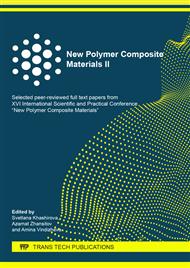[1]
H. Ying, D. Yumin, Y. Jianhong, F. John, X. Kennedy, L. Wang, Synthesis, characterization and antibacterial activity of guanidinylated chitosan, Carbohydrate Polymers. 67 (2007) 66-72.
DOI: 10.1016/j.carbpol.2006.04.015
Google Scholar
[2]
J. Zhishen, Sh. Dongfeng, X. Weiliang, Synthesis and antibacterial activities of quaternary ammonium salt of chitosan, Carbohydrate research. 333 (2001) 1-6.
Google Scholar
[3]
X. Yajun, L. Xiaofei, Ch. Qiang Synthesis and characterization of water-soluble chitosan derivate and its antibacterial activity, Carbohydrate polymers. 69 (2007) 142-147.
DOI: 10.1016/j.carbpol.2006.09.010
Google Scholar
[4]
X.F. Liu, Y.L. Guan, D.Z. Yang, Antibacterial action of chitosan and carboxymethylated chitosan / // Journal of Applied Polymer Science. 79 (2001) 1324-1335.
DOI: 10.1002/1097-4628(20010214)79:7<1324::aid-app210>3.0.co;2-l
Google Scholar
[5]
X. Wenming, X. Peixin, W. Wei, Preparation and antibacterial activity of a water-soluble chitosan derivative, Carbohydrate Polymers. 50 (2002) 35-40.
DOI: 10.1016/s0144-8617(01)00370-8
Google Scholar
[6]
X. Zhao, Q. Zhen-Zhen, H. Jin-Xin, Preparation of Chitosan Biguanidine Hydrochloride and Application in Antimicrobial Finish of Wool Fabric, Journal of Engineered Fibers and Fabrics. 5 (2010) 16-24.
DOI: 10.1177/155892501000500303
Google Scholar
[7]
S. Sun, Q. An, X. Li, L. Qian, B. He, H. Xiao, Synergistic effects of chitosanguanidine complexes on enhancing antimicrobial activity and wet-strength of paper Bioresour, Technol. (2010) 5693.
DOI: 10.1016/j.biortech.2010.02.046
Google Scholar
[8]
L. Qian, X. Li, Sh. Sun, H. Xiao, Preparation of Guanidine Polymer and Its Complex as Dual-Functional Agent for Cellulose Fibre-Based Hygiene Products, Journal of Biobased Materials and Bioenergy. 5 (2011) 219-224.
DOI: 10.1166/jbmb.2011.1137
Google Scholar
[9]
L. Ping, G. Yangyang, S. Zijia, Ch. Dan, G. Ge, D. Alideertu, Synthesis, Characterization, and Bactericidal Evaluation of Chitosan/Guanidine Functionalized Graphene Oxide Composites, Molecules. 22 (2017) 12.
DOI: 10.3390/molecules22010012
Google Scholar
[10]
Y.K. Mathurin, R. Koffi-Nevry, S.T. Guéhi, K. Tano, M.K. Oulé, Antimicrobial activities of polyhexamethylene guanidine hydrochloride-based disinfectant against fungi isolated from cocoa beans and reference strains of bacteria, J. Food Protect. 75 (2012) 1167-1171.
DOI: 10.4315/0362-028x.jfp-11-361
Google Scholar
[11]
L. Qian, Y. Guan, B. He, H. Xiao, Modified guanidine polymers: synthesis and antimicrobial mechanism revealed by AFM, Polymer. 49 (2008) 2471.
DOI: 10.1016/j.polymer.2008.03.042
Google Scholar
[12]
X. Duan, Y. Jiang, L. Feng, F. Wu, Use of polyhexamethylene guanidine hydrochloride as preservative for preventing and controlling citrus sour rot and its application. Patent USA № 0245079 (2013).
Google Scholar
[13]
T.N. Yudanova, I.F. Skokova, L.I. Gavrikova, L.S. Gal'braikh, Fabrication of textile materials with a combined biological effect, FibreChem. 31 (1999) 90-95.
DOI: 10.1007/bf02358629
Google Scholar
[14]
O. Kukharenko, J.-F. Bardeau, I. Zaets, L. Ovcharenko, O. Tarasyuk, S. Porhyn, I. Mischenko, A. Vovk, S. Rogalsky, N. Kozyrovska, Promising low cost antimicrobial composite material based on bacterial cellulose and polyhexamethylene guanidine hydrochloride, European Polymer Journal. 60 (2014) 247-254.
DOI: 10.1016/j.eurpolymj.2014.09.014
Google Scholar
[15]
Q. Liying, D. Chao, L. Xiangtao, X. Huining, Polyelectrolyte complex containing antimicrobial guanidine-based polymer and its adsorption on cellulose fibers, International Journal of the Biology, Chemistry, Physics, and Technology of Wood. 68 (2014) 158.
Google Scholar
[16]
A. Renken, D. Hunkeler, Polymethylene-co-guanidine based capsules: A mechanistic study of the formation using alginate and cellulose sulphate, Journal of Microencapsulation Micro and Nano Carriers. 24 (2007) 20-39.
DOI: 10.1080/02652040601058418
Google Scholar
[17]
R.S. Blackburn, A. Harvey, L.L. Kettle, J.D. Payne, S.J. Russell, Sorption of poly(hexamethylenebiguanide) on cellulose: mechanism of binding and molecular recognition, Langmuir. 22 (2006) 5636-5644.
DOI: 10.1021/la053002b
Google Scholar
[18]
K. Liu, Preparation of guanidine-modified starch for antimicrobial paper, Journal of Bioresources and Bioproducts. 1 (2016) Р. 3-6.
DOI: 10.21967/jbb.v1i1.39
Google Scholar
[19]
Z.A. Tlupova, A.A. Zhansitov, S.A. Elcsheparova, S.Yu. Khashirova, New water-soluble bactericidal materials based on dialdehyde cellulose and diallyl guanidine derivatives, Fundamental research. 11 (2012) 970-974.
Google Scholar
[20]
A.A. Khashirov, A.A. Zhansitov, S.Y. Khashirova, G.E. Zaikov, New biologically active composite materials on the basis of dialdehyde cellulose. Proceedings of the 7th International Conference on Times of Polymers (TOP) and Composites. 2014, pp.550-553.
DOI: 10.1063/1.4876900
Google Scholar
[21]
S.S. Khashirova, A.A. Zhansitov, Z.Y. Isupova, S.A. Elcheparova, S.Y. Khashirova, Acrylate and methacrylate guanidine-ionic liquids for dissolution of cellulose, Materials Science Forum. 935 (2018) 45-48.
DOI: 10.4028/www.scientific.net/msf.935.45
Google Scholar
[22]
Z.Y. Isupova, S.Y. Khashirova, A.A. Zhansitov, V.A. Kvashin, E.V. Khakyasheva, Y.I. Musaev, Y.A. Malkanduev, New metal complexes derived from guanidine-containing dialdehyde cellulose, Fibre Chemistry. 49 (2018) 437-441.
DOI: 10.1007/s10692-018-9916-0
Google Scholar
[23]
Z.Yu. Isupova, S.Yu. Khashirova, A.A. Zhansitov, S.A. Elcheparova, Z.L. Beslaneeva, I.V. Dolbin, Study of complexes of polymethacrylate guanidine with magnesium ions, Fibre Chemistry. 50 (2018) 49-52.
DOI: 10.1007/s10692-018-9928-9
Google Scholar
[24]
Z.Yu. Isupova, Synthesis and study of composite polymer metal complexes based on guanidine polymethacrylate and cellulose dialdehyde with iron (II) ions, Fundamental research. 10 (2018) 12-17.
DOI: 10.17513/fr.42273
Google Scholar
[25]
Z.Y. Isupova, A.A. Zhansitov, S.S. Khashirova, S.Y. Khashirova, Spectrophotometric study of complex compounds of polyacrylate and polymethacrylate of guanidine, and also of composites on their basis with Fe (II) ions, Materials Science Forum. 935 (2018) 1-4.
DOI: 10.4028/www.scientific.net/msf.935.1
Google Scholar


